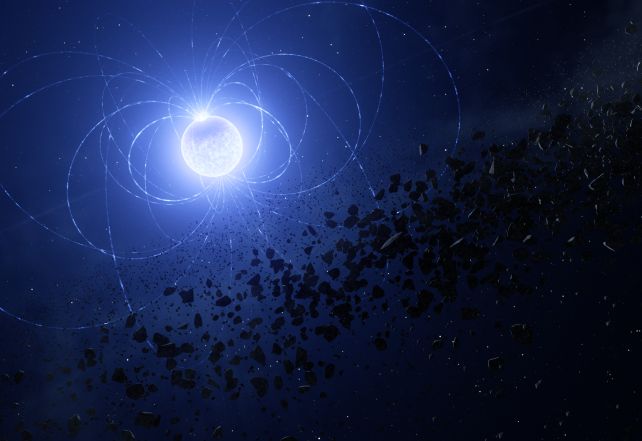The dastardly deeds of a dead star have been discovered by an intrepid team of cosmic detectives.
A white dwarf star that devoured at least a chunk of one of its planets has been betrayed by a scar of vaporized metal marring it surface – the tell-tale remnants of the planet that once orbited the star before spiraling into its doom.
What makes it even more interesting is that rather than spreading out across the surface of the star, the material was localized to one place. It's a discovery that helps necroplanetologists understand exactly how these stellar remnants swallow the planets that once sailed around them in serene orbits.
"It is well known that some white dwarfs – slowly cooling embers of stars like our Sun – are cannibalizing pieces of their planetary systems," says astronomer Stefano Bagnulo of Armagh Observatory and Planetarium. "Now we have discovered that the star's magnetic field plays a key role in this process, resulting in a scar on the white dwarf's surface."
White dwarfs are what remain when a star like the Sun has ended its main-sequence lifespan. As they run out of material to fuse in their cores, these stars puff up and out into enormous red giants before finally ejecting their outer material. The core, no longer supported by fusion, collapses under gravity, forming a dense object up to 1.4 Suns in mass, packed into a sphere around the size of Earth.

These death throes are extremely energetic, and the remnant core is extremely hot; it will continue to shine with residual heat for what could be trillions of years. That's the white dwarf star.
Shockingly, planets have been found continuing to orbit white dwarf stars, suggesting they're able to survive this process.
On the other hand, planetary material has been found in the atmospheres of white dwarfs, indicating not surviving planets live happily ever after. These stars are known as polluted white dwarfs, and they're another way to study planets that have survived the death process of the precursor star. That's because a planet's heavier elements should sink towards the core of a white dwarf pretty quickly; a polluted white dwarf is one that has snacked recently.
But a polluted white dwarf named WD 0816-310 is unlike any other that we have seen. Previous observations revealed the presence of sodium, magnesium, calcium, chromium, manganese, iron, and nickel. Bagnulo and his team wanted to confirm and analyze these detections, and figure out what they could tell us about the object eaten by the star.
They took new observations, and quantified the strength of the stellar spectra that signified the presence of metallic elements. And what they could infer about the object was amazingly precise.
"We have demonstrated that these metals originate from a planetary fragment as large as or possibly larger than Vesta, which is about 500 kilometers (310 miles) across and the second-largest asteroid in the Solar System," says astronomer Jay Farihi of University College London.
But the team picked up something new in their observations. The strength of the elemental signal changed as the star rotated. This strongly suggested that, rather than spreading out evenly throughout the star's atmosphere, the vaporized metals remained confined to one location.
But the researchers also found a clue as to how this happened. The changes in the signal's strength were synchronized to changes in the strength of the star's magnetic field, implying a correlation between the structure of the white dwarf's magnetic field and the local surface density of metallic elements.
"Surprisingly, the material was not evenly mixed over the surface of the star, as predicted by theory. Instead, this scar is a concentrated patch of planetary material, held in place by the same magnetic field that has guided the infalling fragments," says astronomer John Landstreet of Western University in Canada. "Nothing like this has been seen before."
This discovery suggests that as planetary material falls onto the white dwarf it is funneled by the magnetic field, which then keeps the material in place. The reason we've never seen this before, the researchers posit, is because generally only one snapshot of a white dwarf's spectrum is ever obtained.
Taking multiple observations, over years, revealed a variability that can't be detected in just a single observation. Perhaps if we revisit some of the other polluted white dwarfs detected over the years, we might find a few surprises.
The research has been published in The Astrophysical Journal Letters.
